Predictive Modeling of Wildfire Occurrence and Damage in a Tropical Savanna Ecosystem of West Africa
Abstract
:1. Introduction
2. Materials and Methods
2.1. Study Area
2.2. Active Fire and Burned Area Data
2.3. ARIMA Modeling
3. Results
3.1. Study of the Stationarity
3.2. Dependency Analysis
3.3. Wildfire Activity Modeling
3.4. Model Assessment
3.5. Forecast of Wildfires’ Dynamics
4. Discussion
5. Conclusions
Supplementary Materials
Author Contributions
Funding
Acknowledgments
Conflicts of Interest
References
- Kouassi, J.-L.; Wandan, N.; Mbow, C. Assessing the Impact of Climate Variability on Wildfires in the N’Zi River Watershed in Central Côte d’Ivoire. Fire 2018, 1, 36. [Google Scholar] [CrossRef] [Green Version]
- Kouassi, J.-L. Variabilité Climatique, Dynamique Des Feux de Végétation et Perceptions Locales Dans le Bassin Versant du N’Zi (Centre de la Côte d’Ivoire); Institut National Polytechnique Felix Houphouet-Boigny: Yamoussoukro, Cote d’Ivoire, 2019; Available online: https://tel.archives-ouvertes.fr/tel-02183044 (accessed on 2 May 2020).
- Mbow, C.; Nielsen, T.T.; Rasmussen, K. Savanna Fires in East-Central Senegal: Distribution Patterns, Resource Management and Perceptions. Hum. Ecol. 2000, 28, 561–583. [Google Scholar] [CrossRef]
- Etc Terra-Rongead; BNETD. Analyse Qualitative des Facteurs de Déforestation et de Dégradation des Forêts en Côte d’Ivoire; Ministère de l’Environnement et du Développement Durable: Abidjan, Côte d’Ivoire, 2016.
- Bigot, S. Variabilité Climatique, Interactions et Modifications Environnementales: L’exemple de la Côte d’Ivoire; Université des Sciences et Technologies de Lille: Lille, France, 2005. [Google Scholar]
- FAO. Fire Management Global Assessment 2006; FAO Forestry Paper 151: Rome, Italy, 2007. [Google Scholar]
- Goldammer, J.G.; de Ronde, C. Wildland Fire Management Handbook for Sub-Saharan Africa; Goldammer, J.G., de Ronde, C., Eds.; Global Fire Monitoring Center: Freiburg, Germany, 2004. [Google Scholar]
- MINEF. Campagne Nationale de Lutte Contre Les Feux de Brousse Edition 2016–2017. Available online: http://www.eauxetforets.gouv.ci/index.php/le-minef/actualites/a-la-une/514-campagne-nationale-de-lutte-contre-les-feux-de-brousse-edition-2016–2017 (accessed on 14 June 2017).
- Goldammer, J.G. Global Fire–A Message from the Global Fire Monitoring Center; UN International Strategy for Disaster Reduction: Geneva, Switzerland, 2000. [Google Scholar]
- Goula, B.T.A.; Soro, E.G.; Kouassi, W.; Srohourou, B. Tendances et ruptures au niveau des pluies journalières extrêmes en Côte d’Ivoire (Afrique de l’Ouest). Hydrol. Sci. J. 2012, 57, 1067–1080. [Google Scholar] [CrossRef] [Green Version]
- Kouassi, A.M.; Kouamé, K.F.; Goula, B.T.A.; Lasm, T.; Paturel, J.E.; Biémi, J. Influence de la variabilité climatique et de la modification de l’occupation du sol sur la relation pluie-débit à partir d’une modélisation globale du bassin versant du N’Zi (Bandama) en Côte d’Ivoire. Rev. Ivoir. Des. Sci. Technol. 2008, 11, 207–229. [Google Scholar]
- Fearnside, P.M. Global Warming and Tropical Land-Use Change: Greenhouse Gas Emissions from Biomass Burning, Decomposition and Soils in Forest Conversion, Shifting Cultivation and Secondary Vegetation. Clim. Chang. 2000, 46, 115–158. [Google Scholar] [CrossRef]
- IPCC. Climate Change 2014: Impacts, Adaptation, and Vulnerability. Part B: Regional Aspects. Contribution of Working Group II to the Fifth Assessment Report of the Intergovernmental Panel on Climate Change; Barros, V.R., Field, C.B., Dokken, D.J., Mastrandrea, M.D., Mach, K.J., Bilir, T.E., Chatterjee, M., Ebi, K.L., Estrada, Y.O., Genova, R.C., et al., Eds.; Cambridge University Press: Cambridge, UK, 2014. [Google Scholar]
- Owen, G.; McLeod, J.D.; Kolden, C.A.; Ferguson, D.B.; Brown, T.J. Wildfire Management and Forecasting Fire Potential: The Roles of Climate Information and Social Networks in the Southwest United States. Weather Clim. Soc. 2012, 4, 90–102. [Google Scholar] [CrossRef] [Green Version]
- Prestemon, J.P.; Butry, D.T.; Thomas, D.S. The net benefits of human-ignited wildfire forecasting: The case of tribal land units in the United States. Int. J. Wildl. Fire 2016, 25, 390. [Google Scholar] [CrossRef] [Green Version]
- Haines, D.; Main, W.; Johnson, V. Relation between the U.S. National Fire Danger Rating System Spread Component and Fire Activity in the Lake States; US Department of Agriculture: St. Paul, MN, USA, 1970.
- Haines, D.A.; Main, W.A.; Frost, J.S.; Simard, A.J. Fire-danger rating and wildfire occurrence in the Northeastern United States. For. Sci. 1983, 29, 679–696. [Google Scholar] [CrossRef]
- Viedma, O.; Angeler, D.G.; Moreno, J.M. Landscape structural features control fire size in a Mediterranean forested area of central Spain. Int. J. Wildl. Fire 2009, 18, 575. [Google Scholar] [CrossRef]
- Mbow, C.; Goïta, K.; Bénié, G.B. Spectral indices and fire behavior simulation for fire risk assessment in savanna ecosystems. Remote Sens. Environ. 2004, 91, 1–13. [Google Scholar] [CrossRef]
- Ordóñez, C.; Saavedra, A.; Rodríguez-Pérez, J.R.; Castedo-Dorado, F.; Covián, E. Using model-based geostatistics to predict lightning-caused wildfires. Environ. Model. Softw. 2012, 29, 44–50. [Google Scholar] [CrossRef]
- Sow, M.; Mbow, C.; Hély, C.; Fensholt, R.; Sambou, B. Estimation of herbaceous fuel moisture content using vegetation indices and land surface temperature from MODIS data. Remote Sens. 2013, 5, 2617–2638. [Google Scholar] [CrossRef] [Green Version]
- Catry, F.X.; Rego, F.C.; Bação, F.L.; Moreira, F. Modeling and mapping wildfire ignition risk in Portugal. Int. J. Wildl. Fire 2009, 18, 921. [Google Scholar] [CrossRef] [Green Version]
- Chas-Amil, M.L.; Prestemon, J.P.; McClean, C.J.; Touza, J. Human-ignited wildfire patterns and responses to policy shifts. Appl. Geogr. 2015, 56, 164–176. [Google Scholar] [CrossRef]
- Chuvieco, E.; Aguado, I.; Yebra, M.; Nieto, H.; Salas, J.; Martín, M.P.; Vilar, L.; Martínez, J.; Martín, S.; Ibarra, P.; et al. Development of a framework for fire risk assessment using remote sensing and geographic information system technologies. Ecol. Model. 2010, 221, 46–58. [Google Scholar] [CrossRef]
- Martínez, J.; Vega-Garcia, C.; Chuvieco, E. Human-caused wildfire risk rating for prevention planning in Spain. J. Environ. Manag. 2009, 90, 1241–1252. [Google Scholar] [CrossRef]
- Padilla, M.; Vega-García, C. On the comparative importance of fire danger rating indices and their integration with spatial and temporal variables for predicting daily human-caused fire occurrences in Spain. Int. J. Wildl. Fire 2011, 20, 46. [Google Scholar] [CrossRef]
- Preisler, H.K.; Westerling, A.L. Statistical model for forecasting monthly large wildfire events in Western United States. J. Appl. Meteorol. Clim. 2007, 46, 1020–1030. [Google Scholar] [CrossRef] [Green Version]
- Vasconcelos, M.J.P.; Silva, S.; Tomé, M.; Alvim, M.; Pereira, J.M.C. Spatial prediction of fire ignition probabilities: Comparing logistic regression and neural network. Photogramm. Eng. Remote Sens. 2001, 67, 73–81. [Google Scholar]
- Verdú, F.; Salas, J.; Vega-García, C. A multivariate analysis of biophysical factors and forest fires in Spain, 1991–2005. Int. J. Wildl. Fire 2012, 21, 498. [Google Scholar] [CrossRef]
- Arienti, M.C.; Cumming, S.G.; Krawchuk, M.A.; Boutin, S. Road network density correlated with increased lightning fire incidence in the Canadian western boreal forest. Int. J. Wildl. Fire 2009, 18, 970. [Google Scholar] [CrossRef]
- Krawchuk, M.A.; Cumming, S.G.; Flannigan, M.D. Predicted changes in fire weather suggest increases in lightning fire initiation and future area burned in the mixedwood boreal forest. Clim. Chang. 2009, 92, 83–97. [Google Scholar] [CrossRef]
- Liu, D.; Zhang, Y. Research of regional forest fire prediction method based on multivariate linear regression. Int. J. Smart Home 2015, 9, 13–22. [Google Scholar] [CrossRef] [Green Version]
- Mandallaz, D.; Ye, R. Prediction of forest fires with Poisson models. Can. J. Res. 1997, 27, 1685–1694. [Google Scholar] [CrossRef]
- Marchal, J.; Cumming, S.G.; McIntire, E.J.B. Exploiting Poisson additivity to predict fire frequency from maps of fire weather and land cover in boreal forests of Québec, Canada. Ecography 2017, 40, 200–209. [Google Scholar] [CrossRef] [Green Version]
- Papakosta, P.; Straub, D. Probabilistic prediction of daily fire occurrence in the Mediterranean with readily available spatio-temporal data. Iforest 2017, 10, 32–40. [Google Scholar] [CrossRef] [Green Version]
- Viedma, O.; Urbieta, I.R.; Moreno, J.M. Wildfires and the role of their drivers are changing over time in a large rural area of west-central Spain. Sci. Rep. 2018, 8, 17797. [Google Scholar] [CrossRef] [Green Version]
- Boubeta, M.; Lombardía, M.J.; Marey-Pérez, M.F.; Morales, D. Prediction of forest fires occurrences with area-level Poisson mixed models. J. Environ. Manag. 2015, 154, 151–158. [Google Scholar] [CrossRef]
- Serra, P.; Pons, X.; Saurí, D. Land-cover and land-use change in a Mediterranean landscape: A spatial analysis of driving forces integrating biophysical and human factors. Appl. Geogr. 2008, 28, 189–209. [Google Scholar] [CrossRef]
- Amatulli, G.; Rodrigues, M.J.; Trombetti, M.; Lovreglio, R. Assessing long-term fire risk at local scale by means of decision tree technique. J. Geophys. Res. Biogeosci. 2006, 111. [Google Scholar] [CrossRef] [Green Version]
- Argañaraz, J.P.; Gavier Pizarro, G.; Zak, M.; Landi, M.A.; Bellis, L.M. Human and biophysical drivers of fires in Semiarid Chaco mountains of Central Argentina. Sci. Total Environ. 2015, 520, 1–12. [Google Scholar] [CrossRef] [PubMed]
- Sitanggang, I.S.; Yaakob, R.; Mustapha, N.; Ainuddin, A.N. Predictive models for hotspots occurrence using Decision Tree Algorithms and Logistic Regression. J. Appl. Sci. 2013, 13, 252–261. [Google Scholar] [CrossRef]
- Loepfe, L.; Rodrigo, A.; Lloret, F. Two thresholds determine climatic control of forest-fire size in Europe. Biogeosci. Discuss. 2012, 9, 9065–9089. [Google Scholar] [CrossRef]
- Vilar, L.; Woolford, D.G.; Martell, D.L.; Martín, M.P. A model for predicting human-caused wildfire occurrence in the region of Madrid, Spain. Int. J. Wildl. Fire 2010, 19, 325. [Google Scholar] [CrossRef]
- Ruiz-Mirazo, J.; Martínez-Fernández, J.; Vega-García, C. Pastoral wildfires in the Mediterranean: Understanding their linkages to land cover patterns in managed landscapes. J. Environ. Manag. 2012, 98, 43–50. [Google Scholar] [CrossRef] [PubMed]
- Rodrigues, M.; de la Riva, J.; Fotheringham, S. Modeling the spatial variation of the explanatory factors of human-caused wildfires in Spain using geographically weighted logistic regression. Appl. Geogr. 2014, 48, 52–63. [Google Scholar] [CrossRef]
- Penman, T.D.; Nicholson, A.E.; Bradstock, R.A.; Collins, L.; Penman, S.H.; Price, O.F. Reducing the risk of house loss due to wildfires. Environ. Model. Softw. 2015, 67, 12–25. [Google Scholar] [CrossRef]
- Rohde, D.; Corcoran, J.; Chhetri, P. Spatial forecasting of residential urban fires: A Bayesian approach. Comput. Environ. Urban. Syst. 2010, 34, 58–69. [Google Scholar] [CrossRef]
- Romero-Calcerrada, R.; Barrio-Parra, F.; Millington, J.D.A.; Novillo, C.J. Spatial modelling of socioeconomic data to understand patterns of human-caused wildfire ignition risk in the SW of Madrid (central Spain). Ecol. Model. 2010, 221, 34–45. [Google Scholar] [CrossRef]
- Vega Orozco, C.; Tonini, M.; Conedera, M.; Kanveski, M. Cluster recognition in spatial-temporal sequences: The case of forest fires. Geoinformatica 2012, 16, 653–673. [Google Scholar] [CrossRef] [Green Version]
- Mbow, C.; Sambou, B.; Ba, A.T.; Goudiaby, A. Vegetation and fire readiness in main morphological units of Niokolo Koba National Park (Southeast Senegal). Geogr. Tidsskr. J. Geogr. 2003, 103, 55–62. [Google Scholar] [CrossRef]
- Schoenberg, F.P.; Pompa, J.; Chang, C.-H. A note on non-parametric and semi-parametric modeling of wildfire hazard in Los Angeles County, California. Environ. Ecol. Stat. 2009, 16, 251–269. [Google Scholar] [CrossRef] [Green Version]
- Schroeder, M.J. Critical Fire Weather Patterns in the Conterminous United States; Office of Meterological Operations: Washington, DC, USA, 1969. [Google Scholar]
- Podur, J.; Martell, D.L.; Knight, K. Statistical quality control analysis of forest fire activity in Canada. Can. J. Res. 2002, 32, 195–205. [Google Scholar] [CrossRef]
- Crimmins, M.A.; Comrie, A.C. Interactions between antecedent climate and wildfire variability across south-eastern Arizona. Int. J. Wildl. Fire 2004, 13, 455. [Google Scholar] [CrossRef] [Green Version]
- Shahwan, T.; Odening, M. Forecasting agricultural commodity prices using hybrid neural networks. In Computational Intelligence in Economics and Finance; Springer: Berlin/Heidelberg, Germany, 2007; pp. 63–74. [Google Scholar] [CrossRef]
- Khandelwal, I.; Adhikari, R.; Verma, G. Time Series Forecasting Using Hybrid ARIMA and ANN Models Based on DWT Decomposition. Procedia Comput. Sci. 2015, 48, 173–179. [Google Scholar] [CrossRef] [Green Version]
- Zhang, G.P. Time series forecasting using a hybrid ARIMA and neural network model. Neurocomputing 2003, 50, 159–175. [Google Scholar] [CrossRef]
- Box, G.E.P.; Jenkins, G. Time Series Analysis: Forecasting and Control; Holden-Day: San Francisco, CA, USA, 1970. [Google Scholar]
- McKenzie, E. General exponential smoothing and the equivalent arma process. J. Forecast. 1984, 3, 333–344. [Google Scholar] [CrossRef]
- Miller, J.D.; Safford, H.D.; Crimmins, M.; Thode, A.E. Quantitative evidence for increasing forest fire severity in the Sierra Nevada and Southern Cascade Mountains, California and Nevada, USA. Ecosystems 2009, 12, 16–32. [Google Scholar] [CrossRef]
- Taylor, A.H.; Scholl, A.E. Climatic and human influences on fire regimes in mixed conifer forests in Yosemite National Park, USA. Ecol. Manag. 2012, 267, 144–156. [Google Scholar] [CrossRef]
- Boubeta, M.; Lombardía, M.J.; González-Manteiga, W.; Marey-Pérez, M.F. Burned area prediction with semiparametric models. Int. J. Wildl. Fire 2016, 25, 669–678. [Google Scholar] [CrossRef]
- Viganó, H.H.D.G.; De Souza, C.C.; Neto, J.F.R.; Cristaldo, M.F.; De Jesus, L. Previsão e Modelagem das Ocorrências de Incêndios no Pantanal. Rev. Bras. Meteorol. 2018, 33, 306–316. [Google Scholar] [CrossRef]
- Hamilton, J.D. Time Series Analysis; Princeton University Press: Princeton, NJ, USA, 1994. [Google Scholar]
- INS. Recensement Général de la Population et de l’Habitat (RGPH) de 2014; Institut National de la Statistique: Abidjan, Côte d’Ivoire, 2014. [Google Scholar]
- Eldin, M. Le climat. In Le Milieu Naturel de la Côte d’Ivoire; Avenard, J.-M., Eldin, M., Girard, G., Touchebeuf, P., Guillaumet, J.-L., Adjanohoun, E., Perraud, A., Eds.; ORSTOM: Paris, France, 1971; pp. 73–108. [Google Scholar]
- Goula, B.T.A.; Savané, I.; Fadika, V.; Konan, B.; Kouadio, G.B. Impact de la variabilité climatique sur les ressources hydriques des bassins du N’Zo et N’Zi en Côte d’Ivoire (Afrique Tropicale Humide). VertigO 2006, 7, 1–12. [Google Scholar] [CrossRef]
- Guillaumet, J. La végétation de la Côte d’Ivoire. In Le Milieu Naturel de la Côte d’Ivoire; Avenard, J.-M., Eldin, M., Girard, G., Touchebeuf, P., Guillaumet, J.-L., Adjanohoun, E., Perraud, A., Eds.; ORSTOM: Paris, France, 1971; pp. 157–263. [Google Scholar]
- Giglio, L.; Schroeder, W.; Justice, C.O. The collection 6 MODIS active fire detection algorithm and fire products. Remote Sens. Environ. 2016, 178, 31–41. [Google Scholar] [CrossRef] [PubMed] [Green Version]
- Schroeder, W.; Oliva, P.; Giglio, L.; Csiszar, I.A. The New VIIRS 375m active fire detection data product: Algorithm description and initial assessment. Remote Sens. Environ. 2014, 143, 85–96. [Google Scholar] [CrossRef]
- Giglio, L.; Boschetti, L.; Roy, D.; Hoffmann, A.A.; Humber, M. Collection 6 MODIS Burned Area Product User’s Guide, 1st ed.; NASA EOSDIS Land Processes DAAC: Sioux Falls, South Dakota, 2016.
- Kaufman, Y.J.; Justice, C.O.; Flynn, L.P.; Kendall, J.D.; Prins, E.M.; Giglio, L.; Ward, D.E.; Menzel, W.P.; Setzer, A.W. Potential global fire monitoring from EOS-MODIS. J. Geophys. Res. Atmos. 1998, 103, 32215–32238. [Google Scholar] [CrossRef]
- LANCE FIRMS. Collection 6 NRT Hotspot/Active Fire Detections MCD14DL. Available online: https://earthdata.nasa.gov/firms (accessed on 21 June 2017).
- LANCE FIRMS. NRT VIIRS 375 m Active Fire product VNP14IMGT. Available online: https://earthdata.nasa.gov/firms (accessed on 21 June 2017).
- Giglio, L.; Justice, C.; Boschetti, L.; Roy, D. MCD64A1 MODIS/Terra + Aqua Burned Area Monthly L3 Global 500m SIN Grid V006; NASA EOSDIS Land Processes DAAC: Sioux Falls, South Dakota, 2015.
- Hyndman, R.J.; Athanasopoulos, G. Forecasting: Principles and Practice, 2nd ed.; OTexts: Melbourne, Austria, 2018. [Google Scholar]
- Sakulkitbanjong, K.; Pongchavalit, C.; Garivait, S. Time series analysis and forecasting of forest fire weather. In Proceedings of the 98th The IIER International Conference, Pattaya, Thailand, 10–11 March 2017; pp. 6–12. [Google Scholar]
- Shumway, R.H.; Stoffer, D.S. Time Series Analysis and its Applications; Springer Texts in Statistics; Springer International Publishing: Cham, Switzerland, 2017. [Google Scholar]
- Hyndman, R.J.; Khandakar, Y. Automatic Time Series Forecasting: The forecast Package for R. J. Stat. Softw. 2008, 27. [Google Scholar] [CrossRef] [Green Version]
- Hyndman, R.J.; Khandakar, Y. Forecast: Forecasting functions for time series and linear models. J. Stat. Softw. 2016, 26, 1–22. [Google Scholar]
- Coghlan, A. A Little Book of R for Time Series; Wellcome Trust Sanger Institute: Cambridge, UK, 2014. [Google Scholar]
- James, G.; Witten, D.; Hastie, T. An Introduction to Statistical Learning: With Applications in R; Springer Science+Business Media: New York, NY, USA, 2014. [Google Scholar]
- Kuhn, M. Caret: Classification and Regression Training 2020. Available online: https://cran.r-project.org/package=caret (accessed on 1 February 2020).
- Hyndman, R.; Athanasopoulos, G.; Bergmeir, C.; Caceres, G.; Chhay, L.; O’Hara-Wild, M.; Petropoulos, F.; Razbash, S.; Wang, E.; Yasmeen, F. Forecast: Forecasting Functions for Time Series and Linear Models. 2018. Available online: http://pkg.robjhyndman.com/forecast (accessed on 2 April 2020).
- Pohlert, T. Non-Parametric Trend Tests and Change-Point Detection. Available online: https://cran.r-project.org/web/packages/trend/vignettes/trend.pdf (accessed on 30 July 2018).
- R Core Team. R: A Language and Environment for Statistical Computing; R Foundation for Statistical Computing: Vienna, Austria, 2019. [Google Scholar]
- Taylor, S.W.; Woolford, D.G.; Dean, C.B.; Martell, D.L. Wildfire prediction to inform fire management: Statistical science challenges. Stat. Sci. 2013, 28, 586–615. [Google Scholar] [CrossRef] [Green Version]
- Yates, K.L.; Bouchet, P.J.; Caley, M.J.; Mengersen, K.; Randin, C.F.; Parnell, S.; Fielding, A.H.; Bamford, A.J.; Ban, S.; Barbosa, A.M.; et al. Outstanding Challenges in the Transferability of Ecological Models. Trends Ecol. Evol. 2018, 33, 790–802. [Google Scholar] [CrossRef] [Green Version]
- Newman, E.A.; Kennedy, M.C.; Falk, D.A.; McKenzie, D. Scaling and Complexity in Landscape Ecology. Front. Ecol. Evol. 2019, 7, 293. [Google Scholar] [CrossRef] [Green Version]
- Devineau, J.L.; Fournier, A.; Nignan, S. Savanna fire regimes assessment with MODIS fire data: Their relationship to land cover and plant species distribution in western Burkina Faso (West Africa). J. Arid Environ. 2010, 74, 1092–1101. [Google Scholar] [CrossRef] [Green Version]
- Anggraeni, W.; Vinarti, R.A.; Kurniawati, Y.D. Performance Comparisons between Arima and Arimax Method in Moslem Kids Clothes Demand Forecasting: Case Study. Procedia Comput. Sci. 2015, 72, 630–637. [Google Scholar] [CrossRef] [Green Version]
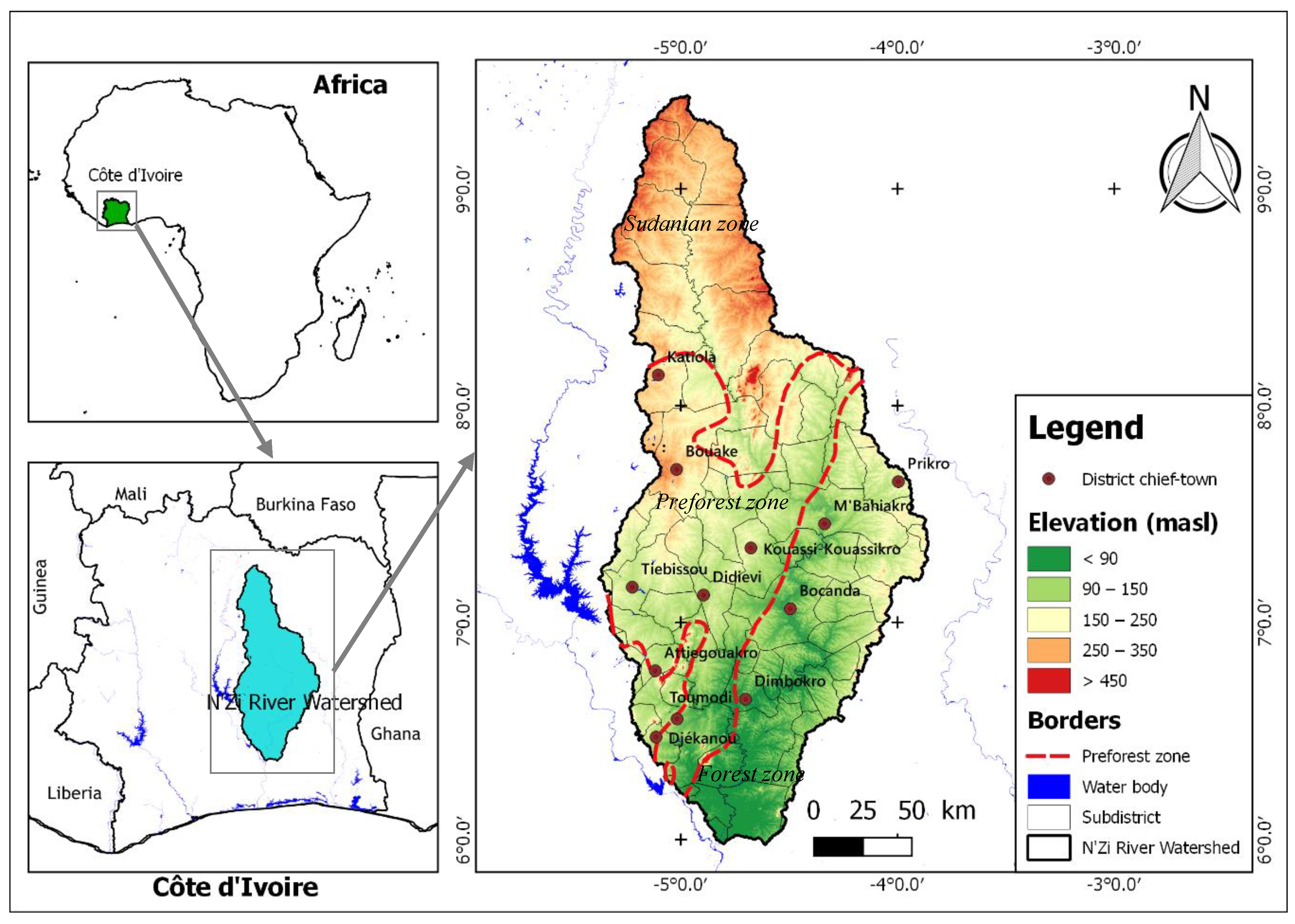
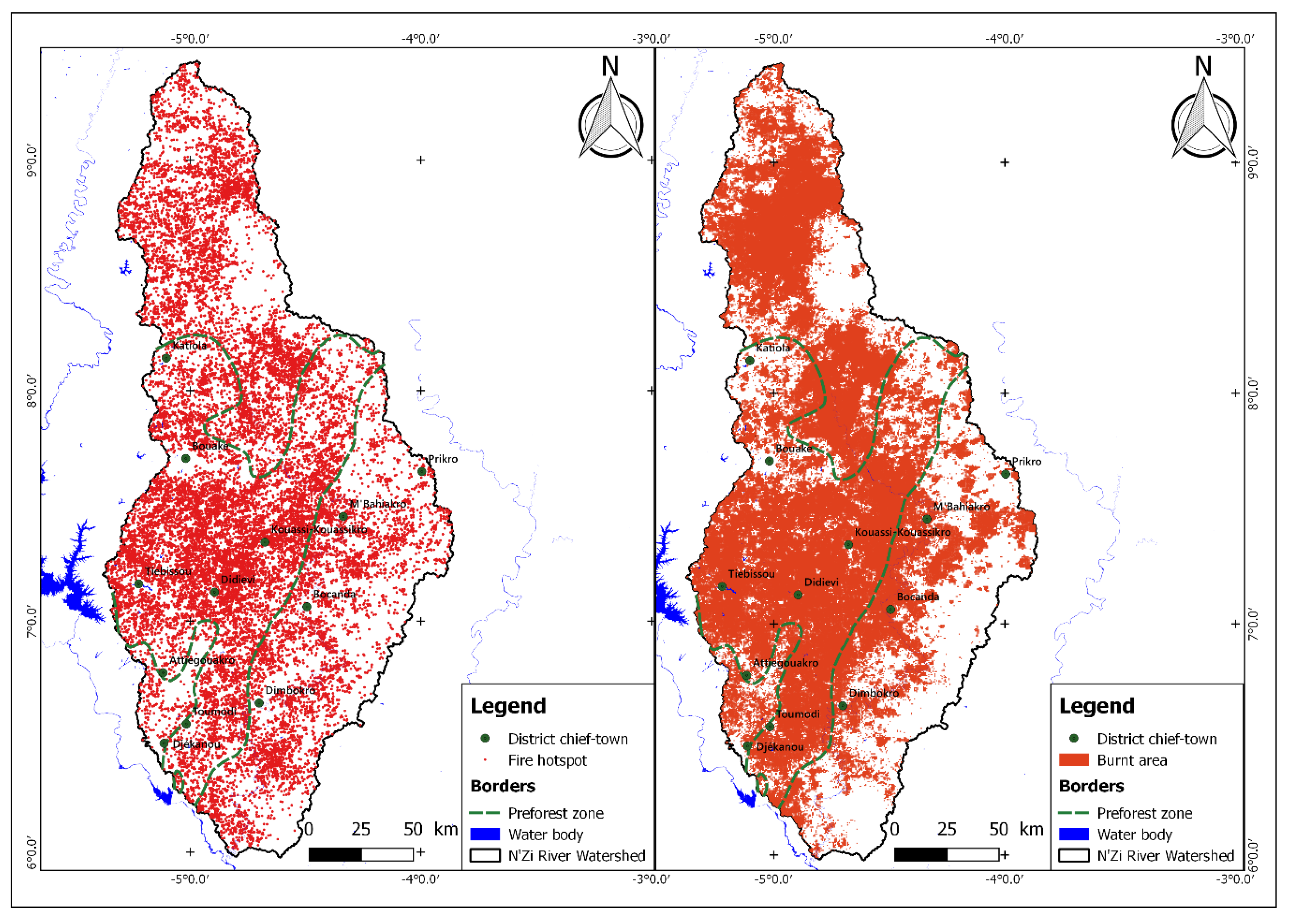
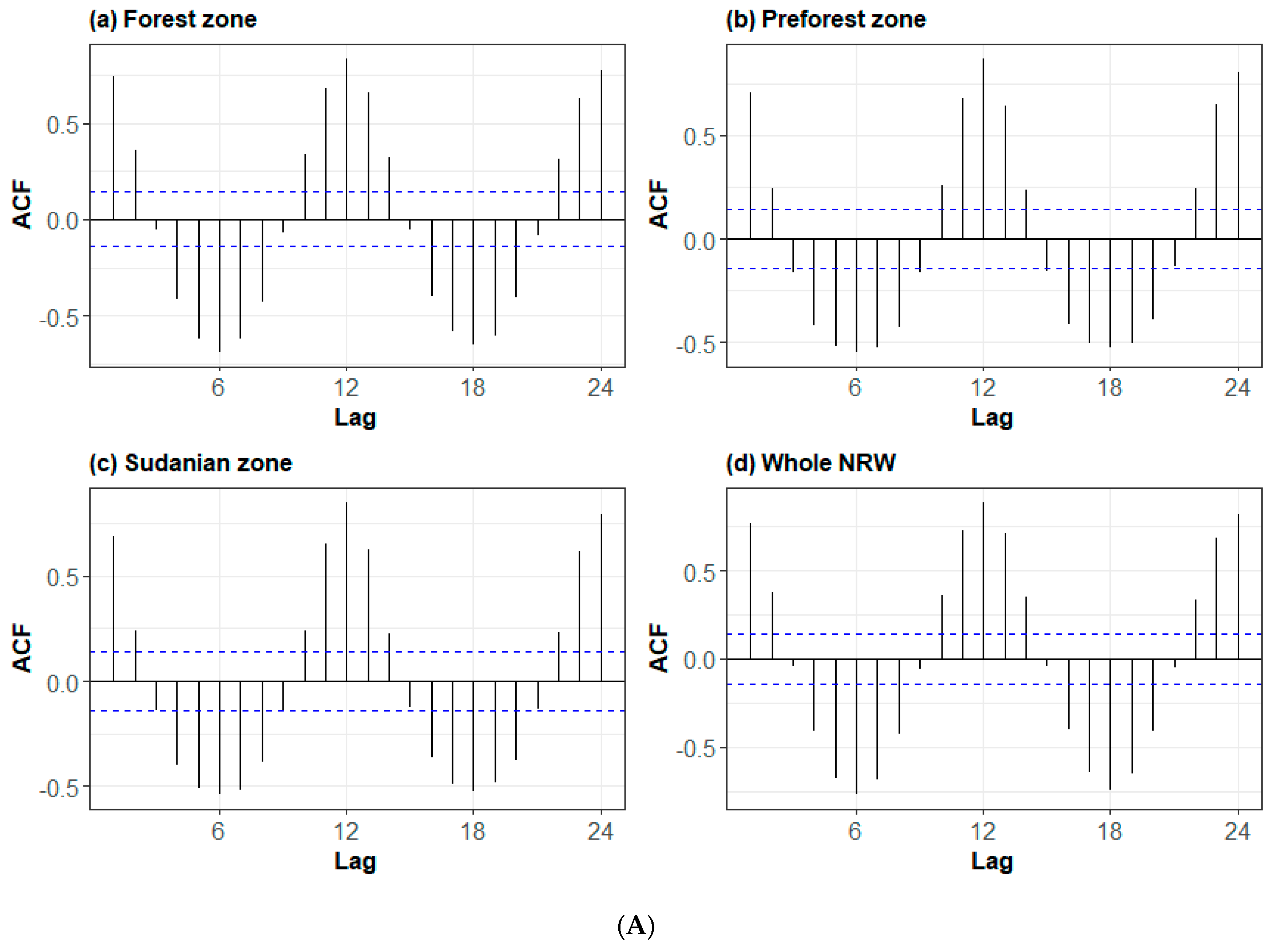
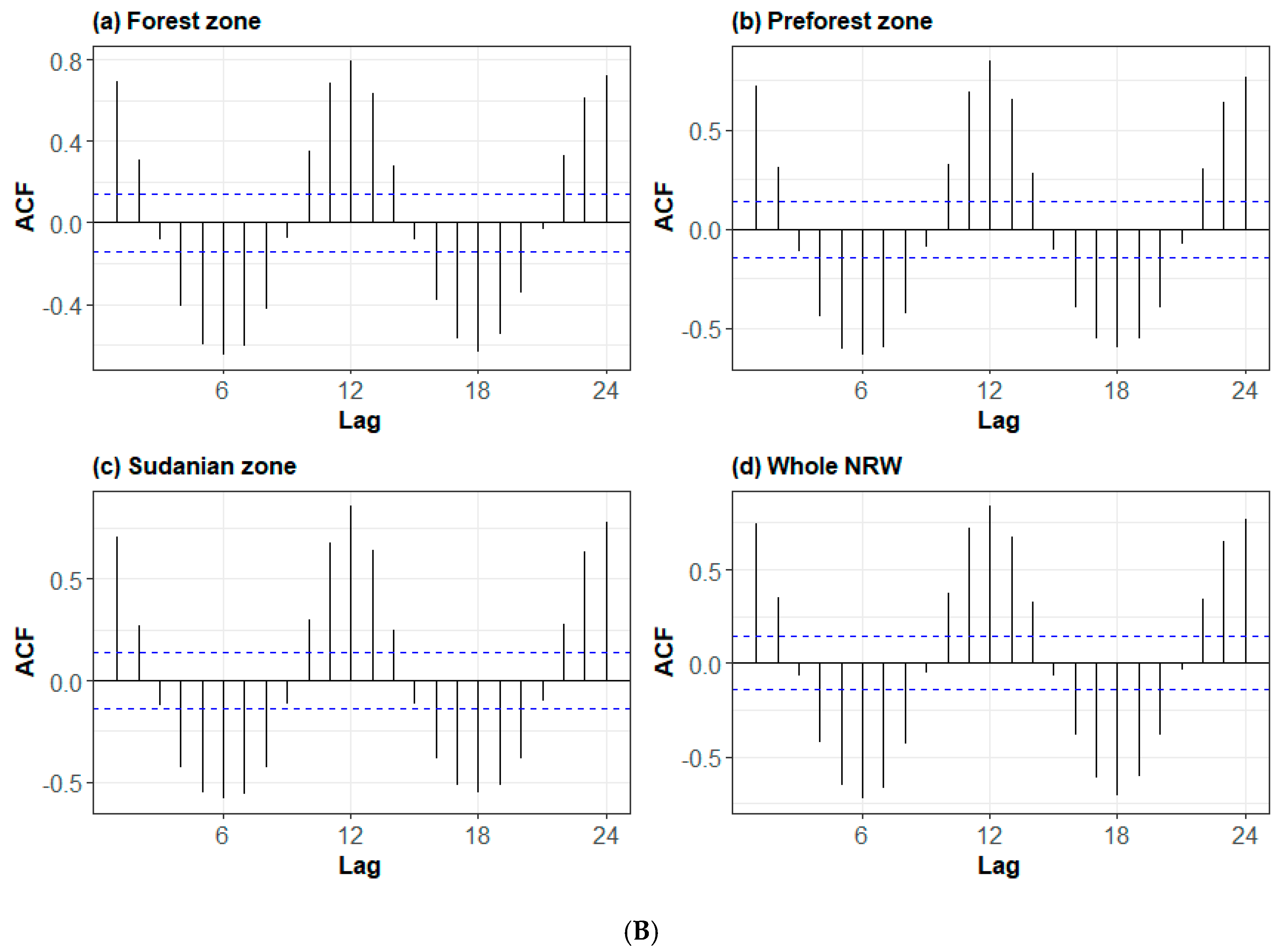
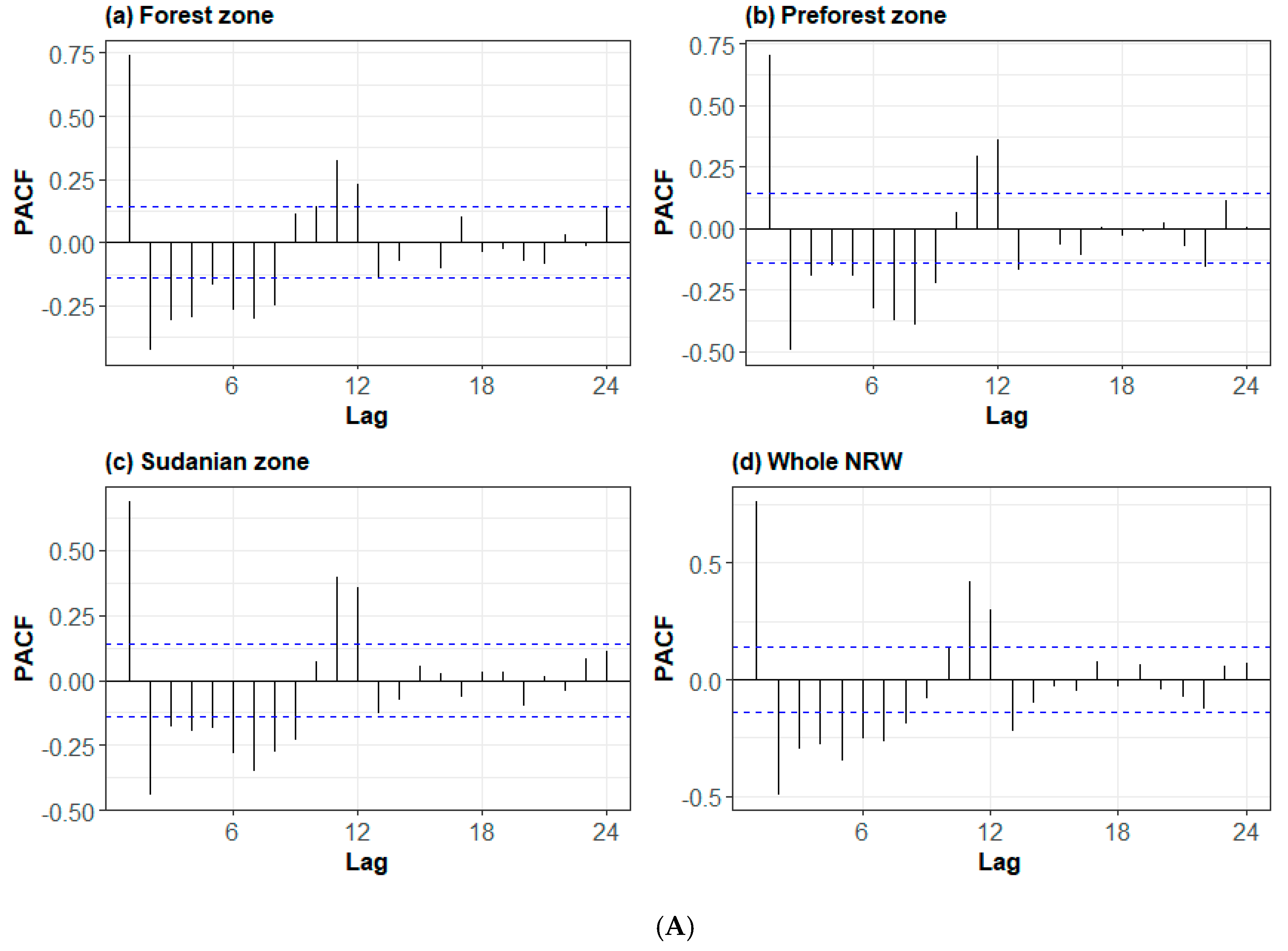

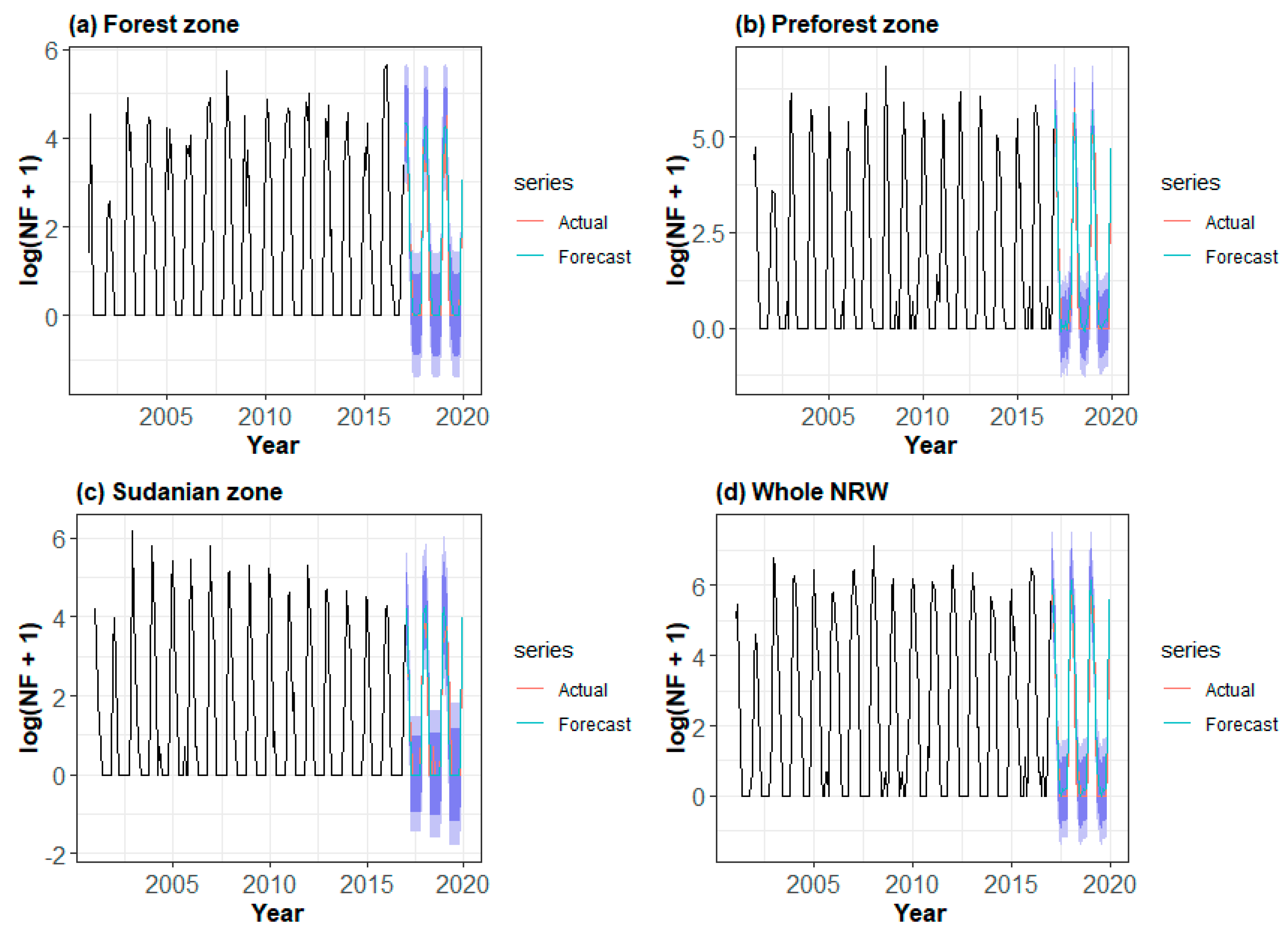

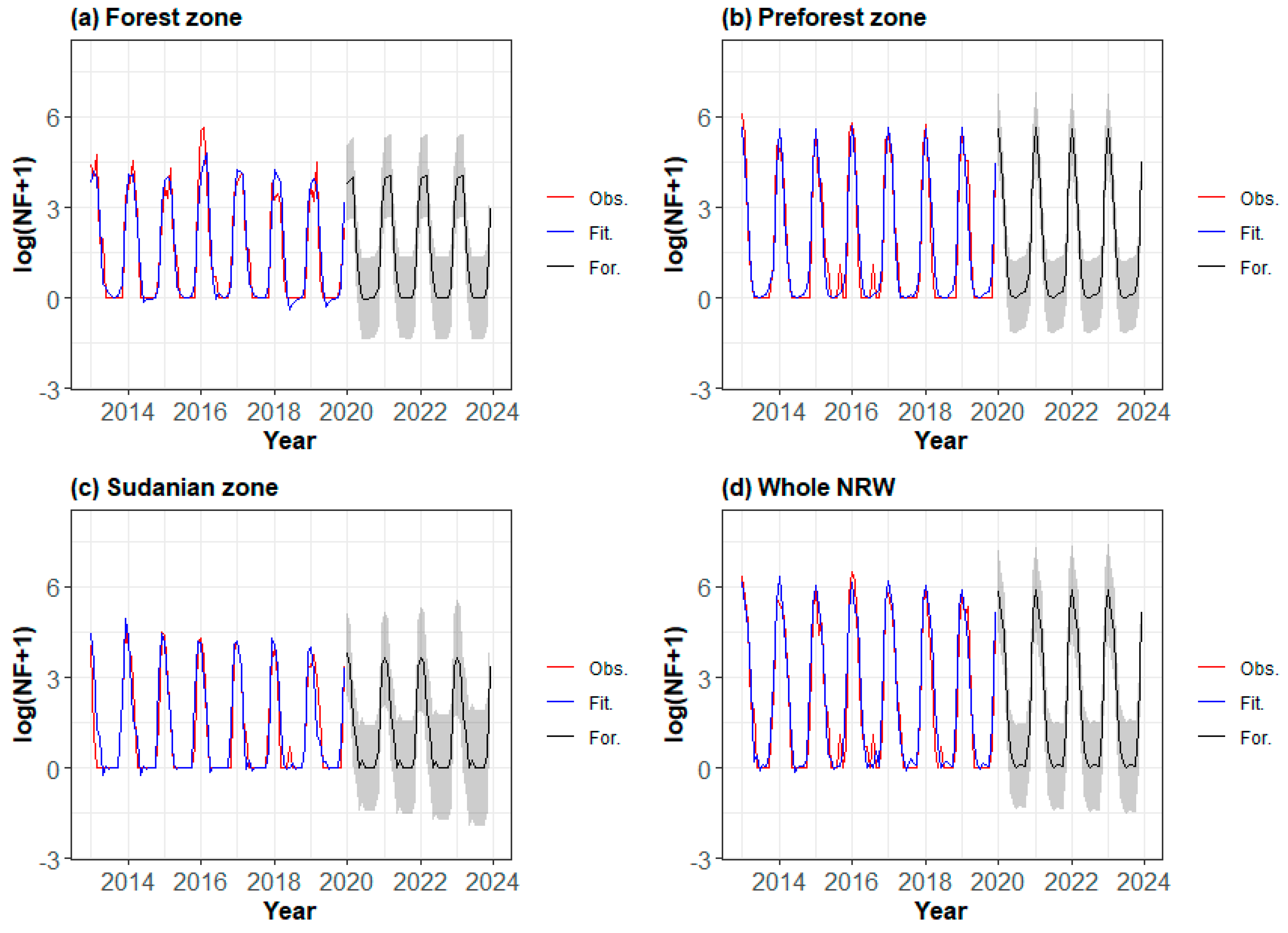

| Time Series | Location | ADF Test | KPSS Test | |||
|---|---|---|---|---|---|---|
| t-Test | p-Value | Statistics | Critical Values | |||
| 5% | 1% | |||||
| Number of wildfires | FZ | −2.789 | 0.203 | 0.030 | 0.463 | 0.739 |
| PFZ | −2.957 | 0.147 | 0.014 | 0.463 | 0.739 | |
| SZ | −2.922 | 0.158 | 0.039 | 0.463 | 0.739 | |
| NRW | −2.443 | 0.356 | 0.019 | 0.463 | 0.739 | |
| Burnt areas | FZ | −3.390 | 0.056 | 0.017 | 0.463 | 0.739 |
| PFZ | −3.291 | 0.071 | 0.013 | 0.463 | 0.739 | |
| SZ | −3.235 | 0.081 | 0.032 | 0.463 | 0.739 | |
| NRW | −3.364 | 0.059 | 0.029 | 0.463 | 0.739 | |
| Time Series | Location | Order | Coefficient | AICc | ||||||||||
|---|---|---|---|---|---|---|---|---|---|---|---|---|---|---|
| p | d | q | P | D | Q | S | AR1 | SAR1 | SAR2 | MA1 | SMA1 | |||
| Number of wildfires [log(NF + 1)] | FZ | 1 | 0 | 1 | 0 | 1 | 1 | 12 | 0.6248 *** | −0.3271 ns | −0.8716 *** | 385.69 | ||
| PFZ | 0 | 0 | 0 | 2 | 1 | 1 | 12 | 0.0036 ns | −0.2504 * | −0.8737 *** | 730.92 | |||
| SZ | 0 | 0 | 1 | 2 | 1 | 0 | 12 | −0.5581 *** | −0.1797 * | 0.2183 ** | - | 407.56 | ||
| NRW | 0 | 0 | 1 | 0 | 1 | 1 | 12 | - | 0.1778 ** | −0.8722 * | 404.94 | |||
| Burnt areas [log(SB + 1)] | FZ | 0 | 0 | 0 | 2 | 1 | 1 | 12 | −0.254 ns | −0.3337 * | −0.4946 * | 747.44 | ||
| PFZ | 1 | 0 | 0 | 2 | 1 | 0 | 12 | 0.1135 ns | −0.5715 *** | −0.5358 *** | 694.71 | |||
| SZ | 0 | 0 | 1 | 2 | 1 | 0 | 12 | −0.4984 *** | −0.4515 *** | 0.1523 ns | 684.03 | |||
| NRW | 0 | 0 | 1 | 2 | 1 | 1 | 12 | −0.4245 ** | −0.4809 *** | 0.113 ns | −0.3559 * | 705.67 | ||
| Time Series | Location | Ljung–Box Test | ||
|---|---|---|---|---|
| Model | Q* | p-Value | ||
| Number of wildfires [log(NF + 1)] | FZ | ARIMA(1,0,1)(0,1,1)12 | 19.828 | 0.532 |
| PFZ | ARIMA(0,0,0)(2,1,1)12 | 21.649 | 0.420 | |
| SZ | ARIMA(0,0,1)(2,1,0)12 | 16.431 | 0.745 | |
| NRW | ARIMA(0,0,1)(0,1,1)12 | 20.483 | 0.553 | |
| Burnt areas [log(SB + 1)] | FZ | ARIMA(0,0,0)(2,1,1)12 | 24.356 | 0.276 |
| PFZ | ARIMA(1,0,0)(2,1,0)12 | 10.735 | 0.968 | |
| SZ | ARIMA(0,0,1)(2,1,1)12 | 18.110 | 0.580 | |
| NRW | ARIMA(0,0,1)(2,1,0)12 | 22.455 | 0.373 | |
| Time Series | Location | Data Type | Errors | ||
|---|---|---|---|---|---|
| RMSE | MAE | MASE | |||
| Number of wildfires [log(NF + 1)] | FZ | Train set | 0.6375 | 0.4177 | 0.8158 |
| Test set | 0.5988 | 0.4188 | 0.8181 | ||
| PFZ | Train set | 0.5948 | 0.3781 | 0.7035 | |
| Test set | 0.5835 | 0.3727 | 0.6935 | ||
| SZ | Train set | 0.7028 | 0.3988 | 0.8686 | |
| Test set | 0.5884 | 0.3320 | 0.7231 | ||
| NRW | Train set | 0.6765 | 0.4530 | 0.7956 | |
| Test set | 0.6527 | 0.4674 | 0.8209 | ||
| Burnt areas [log(SB + 1)] | FZ | Train set | 1.6909 | 0.9354 | 0.7625 |
| Test set | 1.4606 | 0.8383 | 0.6834 | ||
| PFZ | Train set | 1.5344 | 0.8072 | 0.7568 | |
| Test set | 1.4919 | 0.6518 | 0.6110 | ||
| SZ | Train set | 1.5017 | 0.8041 | 0.8307 | |
| Test set | 1.2092 | 0.5882 | 0.6077 | ||
| NRW | Train set | 1.5566 | 0.8687 | 0.6981 | |
| Test set | 1.2112 | 0.7116 | 0.5718 | ||
© 2020 by the authors. Licensee MDPI, Basel, Switzerland. This article is an open access article distributed under the terms and conditions of the Creative Commons Attribution (CC BY) license (http://creativecommons.org/licenses/by/4.0/).
Share and Cite
Kouassi, J.-L.; Wandan, N.; Mbow, C. Predictive Modeling of Wildfire Occurrence and Damage in a Tropical Savanna Ecosystem of West Africa. Fire 2020, 3, 42. https://doi.org/10.3390/fire3030042
Kouassi J-L, Wandan N, Mbow C. Predictive Modeling of Wildfire Occurrence and Damage in a Tropical Savanna Ecosystem of West Africa. Fire. 2020; 3(3):42. https://doi.org/10.3390/fire3030042
Chicago/Turabian StyleKouassi, Jean-Luc, Narcisse Wandan, and Cheikh Mbow. 2020. "Predictive Modeling of Wildfire Occurrence and Damage in a Tropical Savanna Ecosystem of West Africa" Fire 3, no. 3: 42. https://doi.org/10.3390/fire3030042







